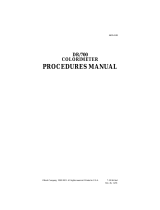Page is loading ...

Oxygen Scavenger
Range(s): 0-1.000 ppm Carbohydrazide, 0-0.700 ppm DEHA, 0-2.450 ppm Erythorbic Acid, 0-2.000 ppm Hydroquinone, 0-3.000 ppm MEKO
Colorimeter Series
Instruction #5578
Procedure
Interferences
Ferrous Iron, all levels – positive interference
To remove interference: Repeat the above procedure,
but do not add Oxygen Scavenger - Reagent B (Step 7).
Record this value; then subtract this value from the initial
test result.
Iron Chelants, all levels – negative interference
Strong Reducing Agents, all levels – positive interference
Sample temperature affects color development.
Note: Glassware that has not been properly cleaned may
contaminate the sample and affect test results. Clean
glassware thoroughly before use with phosphate-free
detergent (available in local stores); then rinse with
Hydrochloric Acid 3N (R-0737) followed by DI
Water (R-0833) or sample water.
Note: Sample temperature should be 72ºF-77ºF
(22ºC-25ºC).
1. Turn on the Colorimeter.
2. Select a test menu (ALL TESTS, RECENT TESTS, or
FAVORITES) containing Oxygen Scav DEHA 0.7 or
alternative oxygen scavenger test (Oxygen Scav Carbo
1, Oxygen Scav Eryth 2.45, Oxygen Scav Hydro 2, or
Oxygen Scav MEKO 3) using .
3. Select appropriate oxygen scavenger test using ;
then press ENTER .
4. Rinse and fill one 25 mm sample cell to 10 mL mark
with DI Water (R-0833). (This will be the blank sample
cell.)
5. Rinse and fill a second 25 mm sample cell to 10 mL
mark with sample.
6. Add 1 mL Oxygen Scavenger - Reagent A to each cell.
7. Add 1 mL Oxygen Scavenger - Reagent B to each cell;
then cap and swirl to mix thoroughly for 10 seconds.
8. Place cells in the dark during the reaction period.
9. Select TIMER using ; then press ENTER .
10. Select START using ; then press ENTER .
(A 10-minute [10:00] countdown will begin.
For Hydroquinone, a 2-minute [02:00] countdown will
begin.)
11. When timer beeps, insert blank sample cell into sample
cell compartment. Align marks per User’s Manual.
12. Select ZERO using ; then press ENTER . Zero
will be displayed.
13. Remove blank sample cell and insert the second sample
cell into sample cell compartment. Align marks.
14. Select READ using ; then press ENTER . The
instrument will read the sample and the result will be
displayed.
(over)
Test Method
Iron Reduction
Under acidic conditions, oxygen scavengers reduce ferric iron to ferrous iron. Ferrozine complexes with ferrous iron to produce a magenta-colored complex that is proportional to the
concentration of oxygen scavenger in a sample.

Application
Ordering Info
01/13
Industrial Water
Reagent Pack
K-8016 Oxygen Scavenger
Formulated for exclusive use with Taylor’s TTi
®
Colorimeter.
Reagent Pack Components
R-8016A Oxygen Scavenger - Reagent A
R-8016B Oxygen Scavenger - Reagent B
R-0833 DI Water
Optional Reagents & Accessories
R-0737 Hydrochloric Acid 3N
31 Loveton Circle, Sparks, MD 21152 U.S.A.
800-TEST KIT (837-8548) • 410-472-4340
0.012 ppm Carbohydrazide
0.010 ppm DEHA
0.033 ppm Erythorbic Acid
0.027 ppm Hydroquinone
0.037 ppm MEKO
Estimated
Detection Limit
Precision
Using a single lot of reagent and a standard solution of 0.234 ppm DEHA, an individual analyst obtained a standard deviation of 0.003 ppm DEHA (equivalent to 0.004
Carbohydrazide
,
0.010 ppm Erythorbic Acid, 0.008 ppm
Hydroquinone, and 0.010 ppm MEKO).
Instruction #5578
/



